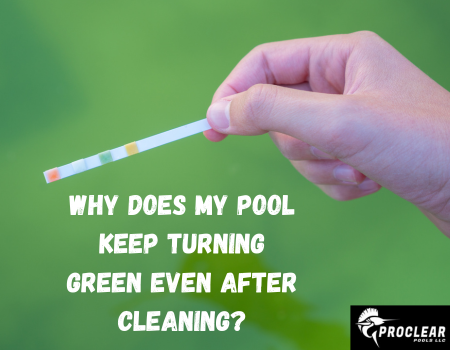You’ve spent hours cleaning, vacuuming, and balancing the chemicals, yet your pool water keeps turning green again. So, what’s going wrong? Understanding the causes of a green pool, as well as the solutions, can help you maintain a sparkling clear pool all season long.
Reasons Your Pool Might be Turning Green After Cleaning
 The Culprit: Algae Growth
The Culprit: Algae Growth
Algae are microscopic plants that thrive in pools when the conditions are right. They can grow on pool walls, floors, and in the water, turning your pool an unsightly green color. Algae thrive in warm, stagnant, and nutrient-rich environments—exactly the type of conditions a poorly maintained pool can offer.
Even after cleaning your pool, if algae aren’t fully removed or prevented, they can quickly return, resulting in your pool turning green once again. Here’s why your pool might keep turning green:
1. Improper Chlorine Levels
When the chlorine levels are too low, algae have an ideal environment to grow. The most common reasons for low chlorine levels are:
- Overuse of the pool: Frequent use can deplete chlorine levels, especially during hot weather when the chlorine dissipates faster.
- Improper chemical balance: High pH levels can cause chlorine to become less effective, allowing algae to thrive.
- Rain and debris: Heavy rain, storms, and debris can wash away chlorine, leaving your pool vulnerable to algae growth.
Solution:
Regularly test pool water regularly to confirm that chlorine levels are within the optimal range (1-3 ppm). If the levels are too low, use a pool shock treatment or add more chlorine to kill algae and bacteria.
2. Poor Circulation
Poor circulation is another reason behind green pool water. The pump and filtration system work together to circulate the water and ensure that chlorine and other chemicals are evenly distributed. If your pool’s pump isn’t running long enough or your filter is clogged, water circulation is compromised, leading to algae growth.
Without proper circulation, the chlorine and other chemicals may not reach all parts of the pool. Algae can begin to form in stagnant areas, causing green water to appear.
Solution:
Ensure that your pool pump runs for at least 8-12 hours per day, especially during the summer months, to maintain adequate water circulation. Check the filter regularly and clean it to ensure it’s functioning properly.
3. Insufficient Pool Shocking
Pool shocking is a process in which you add a large dose of chlorine or other oxidizing chemicals to the pool water to eliminate contaminants, including algae.
Pool shock is particularly important after heavy use, rainstorms, or when your pool has been neglected for a period. If you’re only adding small amounts of chlorine or not shocking the pool frequently enough, algae can easily resurface.
Solution:
If your pool water turns green, it’s often necessary to perform a “super shock,” adding a large dose of chlorine or a specialized algae-killing chemical. Make sure to follow the manufacturer’s instructions for shocking your pool and allow enough time for the chemicals to circulate before swimming.
4. Organic Debris in the Pool
Leaves, dirt, and other organic debris can introduce nutrients into your pool water, which algae use as a food source. Even if you’re cleaning your pool regularly, debris that gets caught in the skimmer or filter can still provide the conditions necessary for algae to grow.
Additionally, some pool cleaning tools or automatic vacuums may push debris into areas that are harder to clean, contributing to algae buildup.
Solution:
Regularly skim the pool and clean the filter. Use a pool vacuum to remove debris from the bottom, and clean the pool walls to prevent buildup. Ensure that your pool’s skimmer and filter basket are emptied frequently to reduce the potential for organic matter accumulation.
5. High Pool Cya (Cyanuric Acid) Levels
Cyanuric acid (Cya) is a stabilizer that helps protect chlorine from being broken down by sunlight. However, too much Cya can cause chlorine to become less effective, leading to algae growth. Over time, Cya levels can accumulate in the pool water, especially if you use stabilized chlorine products or add chlorine tablets without regularly checking Cya levels.
Solution:
Test the Cya levels in your pool, and if they’re too high (over 50 ppm), dilute the water by partially draining the pool and refilling it. Regularly monitor the Cya levels and make adjustments as necessary.
6. Poorly Maintained or Outdated Pool Equipment
Old, broken, or inefficient pool equipment can contribute to a green pool. If your pool’s filter, pump, or other equipment is malfunctioning or outdated, it may not be effectively circulating the water or removing contaminants, allowing algae to thrive.
Solution:
Regularly inspect and maintain the pump, filter, and other components. If your equipment is outdated or inefficient, consider replacing it to ensure optimal performance.
If your pool is still turning green, even after cleaning, is often caused by a combination of factors such as low chlorine levels, poor circulation, organic debris, and improper chemical balance. To prevent your pool from turning green again, it’s essential to maintain proper chlorine levels, regularly shock the pool, ensure proper circulation, and clean the pool frequently.
